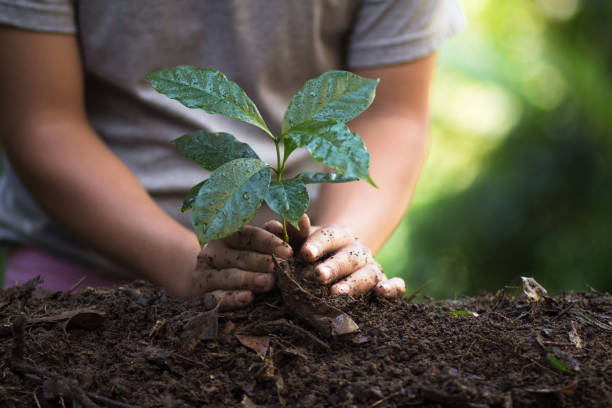Grants for land conservation are a vital lifeline for preserving natural landscapes, ecosystems, and biodiversity.
These financial resources support a wide range of activities, from purchasing land to protect it from development, to restoring habitats that have been degraded, to implementing sustainable land management practices.
The Essence of Land Conservation Grants
At their core, land conservation grants are about safeguarding the planet’s natural treasures for future generations. They are awarded by governments, non-profit organizations, foundations, and even private entities. The goal is to provide financial support to projects that contribute to the conservation of natural spaces, wildlife habitats, and biodiversity.
Why Land Conservation Matters
Imagine waking up one day to find that your favorite hiking trail or the forest you used to camp in as a child has been cleared to make way for a new development. This is where land conservation steps in—to prevent such losses and to ensure that natural areas remain intact and accessible. Conserving land helps combat climate change, protects water sources, preserves habitats for endangered species, and maintains the beauty and ecological integrity of natural landscapes.
How Grants Support Conservation Efforts
Acquisition of Land
One of the most straightforward ways to conserve land is simply to buy it. Grants can provide the necessary funds to acquire parcels of land that are critical for conservation purposes, ensuring they are protected from development or degradation.
Restoration Projects
Many grants focus on restoring lands that have been degraded by pollution, deforestation, or other environmental impacts. This can include reforesting areas, rehabilitating wetlands, and removing invasive species to help native ecosystems thrive once again.
Sustainable Management
Conservation isn’t just about putting a fence around a piece of land and leaving it untouched. It often involves active management to maintain the health of the ecosystem. Grants may support sustainable farming practices, the creation of conservation easements, and the development of management plans that balance human use with ecological preservation.
Research and Education
Understanding ecosystems and how to protect them is crucial. Some grants are dedicated to research projects that explore conservation techniques, biodiversity monitoring, and the impacts of climate change on natural habitats. Additionally, educating the public about the importance of land conservation and how to participate in it is another area where grants can make a significant difference.
Getting Involved
Whether you’re part of an organization that could benefit from a land conservation grant or an individual passionate about protecting natural spaces, there are ways to get involved. Many grant programs are open to applications from a variety of stakeholders, including non-profits, community groups, and sometimes even individuals with a project that aligns with the grant’s goals.
The Future of Land Conservation
The challenges facing natural landscapes are immense, but so are the opportunities for conservation. With continued support through grants and increased public awareness and involvement, the future can be one where natural habitats are not only preserved but flourish. The journey of land conservation is long and complex, but every acre saved is a victory for the planet and a gift to future generations.
Grants for land conservation are more than just funding—they are a manifestation of our collective commitment to protecting the Earth’s irreplaceable natural heritage. Through these efforts, we can ensure that the beauty, diversity, and ecological richness of our planet are preserved for years to come.
Comprehensive list of foundations Awarding Grants for Land Conservation
1. The Nature Conservancy
Mission: The Nature Conservancy aims to conserve the lands and waters on which all life depends. It’s one of the most well-known and widespread conservation organizations, operating in dozens of countries and supporting a variety of conservation initiatives.
Focus Areas: Their work spans from protecting habitats and wildlife to addressing climate change and water conservation. They also engage in policy work and offer conservation grants to like-minded projects and organizations.
2. Conservation International
Mission: Conservation International focuses on protecting nature for the benefit of humanity. They understand that human well-being is deeply connected to the health of the natural world and work to protect ecosystems that are crucial for water, air, and food.
Focus Areas: Their grants support projects in critical areas such as climate action, forest conservation, and sustainable development, with a keen eye on community involvement and indigenous peoples’ rights.
3. The Land Trust Alliance
Mission: This U.S.-based organization works to save the places people love by strengthening land conservation across America. They support over 1,000 member land trusts in their efforts to protect and conserve natural habitats.
Focus Areas: The Land Trust Alliance offers grants that support conservation easements, capacity building for land trusts, and specific conservation projects. They focus on promoting effective land conservation strategies and enhancing the impact of land trusts.
4. World Wildlife Fund (WWF)
Mission: The WWF’s mission is to conserve nature and reduce the most pressing threats to the diversity of life on Earth. They’re known for their work in protecting endangered species, but they also play a significant role in habitat conservation.
Focus Areas: WWF provides funding for projects focused on habitat protection, sustainable resource management, and conservation research. Their efforts span across various ecosystems, including forests, oceans, freshwater, and grasslands.
5. The Global Environment Facility (GEF)
Mission: The GEF serves as a financial mechanism for a number of international environmental conventions. It aims to address global environmental issues while supporting national sustainable development initiatives.
Focus Areas: Their grants support projects in biodiversity, climate change mitigation and adaptation, land degradation, international waters, chemicals, and waste. The GEF works with countries and other partners to fund projects that have a significant impact on global environmental health.
6. The David and Lucile Packard Foundation
Mission: While this foundation has a broad focus, including health and children’s issues, it also dedicates significant resources to conservation and science. Their aim is to improve the condition of the natural world, particularly the ocean and land use.
Focus Areas: The foundation awards grants for ocean conservation, climate change mitigation, and sustainable agriculture practices. They emphasize science-based solutions and partnerships with other organizations to amplify their impact.
7. The Gordon and Betty Moore Foundation
Mission: The foundation seeks to create positive outcomes for future generations. In the environmental sector, their work focuses on preserving critical ecosystems and promoting sustainable use of resources.
Focus Areas: They fund projects related to forest conservation, marine conservation, and environmental science. The foundation is particularly interested in protecting biodiversity and supporting sustainable industries that reduce environmental impact.
Engaging with These Foundations
For organizations and individuals interested in land conservation, engaging with these foundations can be a pivotal step. Each foundation has its own priorities and grant application processes, so it’s essential to research and align your project with their goals. Many also offer guidance, resources, and networking opportunities to help amplify the impact of conservation efforts.
How to Apply for Grants for Land Conservation
Step 1: Define Your Project
Start with a Clear Vision: Your first step is to clearly define what you want to achieve. Are you looking to purchase land for conservation, restore a degraded ecosystem, or implement sustainable land management practices? Be specific about your goals.
Understand the Impact: Clearly articulate the environmental impact of your project. How will it contribute to conservation? Will it protect endangered species, preserve biodiversity, or help combat climate change? The more tangible your outcomes, the stronger your application.
Step 2: Research Potential Grants
Identify Your Options: Begin by compiling a list of potential grants. Look for foundations, governmental agencies, non-profit organizations, and corporations that support land conservation projects. Use databases, conservation forums, and networks for leads.
Match Your Project to the Grant: Not all grants will be a good fit for your project. Read the eligibility requirements and funding priorities of each grant carefully. Your project should align closely with the grantor’s goals and objectives.
Step 3: Prepare Your Application
Follow Instructions Carefully: Every grant application will have its own set of instructions. Follow these meticulously. Whether it’s about formatting, word count, or specific documents to include, paying attention to detail is crucial.
Craft a Compelling Narrative: Tell the story of your project. Why is it important? What will it achieve? How does it align with the grantor’s mission? A compelling narrative can make your application stand out.
Include a Detailed Budget: Be clear about how you plan to use the grant funds. Provide a detailed budget that includes all costs associated with your project. Justify each expense and demonstrate how it contributes to your project’s goals.
Showcase Your Capability: Demonstrate your ability to successfully complete the project. Highlight your organization’s experience, expertise, and past successes in land conservation. If you have partners, explain their roles and how they contribute to the project.
Step 4: Submit Your Application
Review Before Submitting: Double-check your application for completeness and accuracy. Make sure you haven’t missed any required information or documents.
Adhere to Deadlines: Submit your application before the deadline. Late submissions are usually not considered.
Step 5: Follow Up
Be Patient: The review process can take time. Grantors often receive many applications and need to evaluate each one carefully.
Respond to Queries: If the grantor contacts you with questions or requests for additional information, respond promptly and thoroughly.
Seek Feedback: If your application is not successful, ask for feedback. Understanding why can help you improve future applications.
Additional Tips
Build Relationships: Engaging with potential funders before you apply can be beneficial. Attend events, participate in forums, and take opportunities to introduce your organization and its mission.
Leverage Other Funding Sources: Showing that you have support from other sources can strengthen your application. It demonstrates confidence in your project from multiple stakeholders.
Stay Positive: Rejection is part of the process. Learn from it, refine your approach, and keep applying.
Applying for grants for land conservation is a process that requires preparation, patience, and persistence. By carefully researching potential grants, crafting a compelling application, and demonstrating your project’s impact, you increase your chances of securing funding. Remember, each application is a step forward in your mission to conserve the natural world. Keep focused on your goals, and let your passion for conservation shine through your application.
Tips for Writing a Successful Grant Proposal for Grants for Land Conservation
Understand the Funder’s Goals
Research Thoroughly: Before you begin writing, invest time in understanding the funder’s mission, values, and past funded projects. This insight will help you tailor your proposal to align with their goals and demonstrate how your project contributes to their objectives.
Follow Guidelines Precisely: Adhere to the funder’s application guidelines meticulously. This includes respecting word limits, answering all questions fully, and submitting all required documents. Ignoring these guidelines can lead to an immediate disqualification.
Clearly Define Your Project
Articulate a Clear Vision: Begin with a concise statement that captures the essence of your project. What are you aiming to achieve? Why is it important? A compelling opening statement can grab the funder’s attention from the start.
Set Specific Goals and Objectives: Break down your vision into tangible goals and measurable objectives. This clarity helps funders understand the impact of your project and how success will be evaluated.
Demonstrate the Need
Highlight the Conservation Need: Use data, research, and compelling narratives to illustrate the environmental need your project addresses. Whether it’s protecting endangered species, preserving a watershed, or restoring a degraded habitat, make the case for why this work is urgent and vital.
Show Your Project’s Unique Value: Explain what makes your project different from other initiatives. How does it offer a novel approach or address a gap in conservation efforts? This uniqueness can make your proposal more compelling.
Outline a Solid Plan
Provide a Detailed Methodology: Describe how you plan to achieve your project’s objectives. Include timelines, activities, and the resources you’ll need. A clear, logical plan reassures funders that you’ve thought through the project thoroughly.
Include a Budget: Present a detailed budget that aligns with your project plan. Be transparent about costs and justify each expense. Funders need to see that you’re efficient and responsible with resources.
Demonstrate Capacity and Collaboration
Highlight Organizational Strengths: Showcase your organization’s experience, expertise, and past successes in land conservation. This builds confidence in your ability to execute the project.
Emphasize Partnerships: If you’re collaborating with other organizations, highlight these partnerships. Show how they enhance the project’s reach, impact, and sustainability.
Communicate the Impact
Detail the Environmental Impact: Clearly articulate the environmental benefits of your project. How will it contribute to biodiversity, climate resilience, or ecological health? Use specific, quantifiable outcomes whenever possible.
Explain the Broader Benefits: Beyond environmental impact, describe any social, economic, or educational benefits. Funders often look for projects that offer multiple layers of value.
Write Compellingly
Tell a Story: Use storytelling to make your proposal engaging. Share stories of the land you’re conserving, the wildlife it supports, or the community it benefits. Emotional connections can be powerful.
Be Clear and Concise: Avoid jargon and overly technical language. Your proposal should be accessible to non-specialists. At the same time, be concise—make every word count.
Review and Revise
Seek Feedback: Before submitting, get feedback from colleagues, experts in your field, or even someone unfamiliar with your project. Fresh eyes can catch errors and offer valuable insights.
Proofread: Ensure your proposal is free from typos, grammatical errors, and inconsistencies. A polished proposal reflects professionalism and attention to detail.
Follow Up
Be Proactive: After submission, don’t hesitate to follow up with the funder if appropriate. A brief thank-you note can be a nice touch, showing appreciation for their consideration.
Crafting a successful grant proposal for land conservation is both an art and a science. It requires a deep understanding of your project and the funder, a clear and compelling presentation of your vision, and meticulous attention to detail. By following these tips, you can increase your chances of securing the funding needed to protect and preserve our planet’s precious natural resources. Remember, each proposal is an opportunity to make a difference for the environment and future generations.
Recommended Books for Enhancing Grant Writing Skills
To further enhance your grant writing skills and stay on top of these trends, consider diving into some insightful literature.
Here are a few recommended books:
- The Ultimate Guide to Federal Grant Applications: Techniques for Success – This book is a must-read for anyone looking to navigate the complex world of federal grant applications. It offers practical techniques, insider tips, and a comprehensive understanding of what it takes to create successful federal grant applications.
- Advanced Grant Writing for Nonprofits : Focuses on sophisticated techniques for experienced grant writers. It delves into complex aspects of proposal development, offering strategies for dealing with competitive grant environments and large funding bodies.
- Mastering Grant Writing: A Nonprofit’s Guide to Effective Proposal Development and Submission: This book serves as a comprehensive guide, covering the entire process of grant writing. It includes tips on understanding funders’ perspectives, crafting compelling narratives, and the nuances of proposal submission.
- Becoming the Grant Guru: Freelancer’s Guide to Success : Tailored for freelance grant writers, this book provides insights into building a successful career in grant writing. It includes strategies for finding clients, managing projects, and maximizing the impact of grant proposals.
- The Small Business’s Guide to Winning Grants : This resource is particularly useful for small businesses looking to secure grants. It offers practical advice on identifying suitable grant opportunities, understanding the requirements of small business grants, and crafting winning proposals.
- Grant Readiness Guide: Preparing to Triumph in Funding Opportunities : A comprehensive resource for organizations at various stages of grant preparedness. It provides a roadmap for developing organizational capacity, aligning projects with funders’ goals, and creating compelling applications.
- Her Capital: Unlocking Women’s Small Business Grants: Specifically designed for women entrepreneurs, this book offers guidance on navigating the landscape of small business grants for women. It includes insights into grant sources, application strategies, and tips for leveraging grants to grow a business.
Unlock Your Grant Success!
Join our email list now for exclusive grant-writing tips and unique grant opportunities delivered straight to your inbox. Click here to Subscribe. Don’t miss out!






